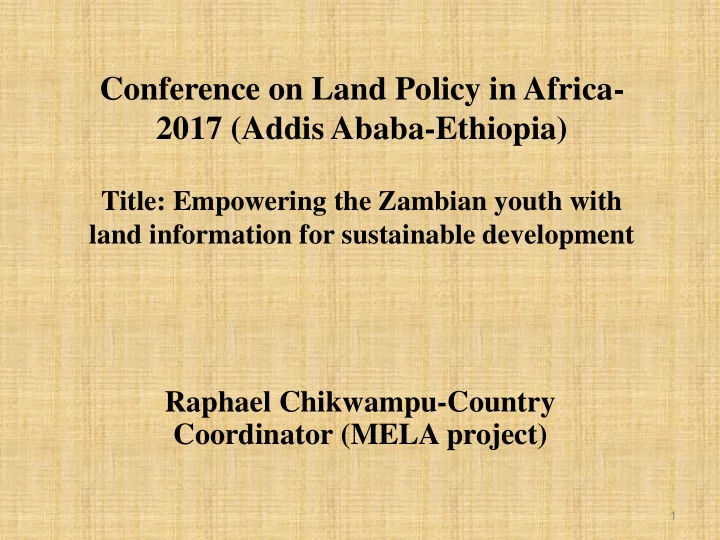

Conference on Land Policy in Africa- 2017 (Addis Ababa-Ethiopia) Title: Empowering the Zambian youth with land information for sustainable development Raphael Chikwampu-Country Coordinator (MELA project) 1
Outline 1.Introduction 2.Land administration in Zambia 3.Problem statement-general 4.Problem statement-land 5.Intervention 6.Conclusion 2
Introduction • Zambia is a landlocked country in Southern Africa, surrounded by 8 neighbours • It has a population of more than 17 million • Economic activities include mining, agriculture, tourism and manufacturing • All these economic activities have land as major production factor • Has size of 752,618 km² 3
Land administration in Zambia State land (leasehold) Customary land (traditional) • • Constitutes 6% of land Constitutes 94% of the land in Zambia (old stats) • Well documented with clear • Managed according to traditional guidelines norms and practices • Ministry of Lands responsible for • Characterised by poor documentation administration (Commissioner of (allocation, ownership & boundary) Lands) • Gender inequalities in allocation • Other ministries have planning (cultural practices) authority (agriculture, tourism, • Limited transparency in allocation mines, water & energy) • Some traditional leaders sale land • (can’t be challenged by subjects) Long and cumbersome land acquisition procedures • Most customary land inhabitants have • limited knowledge on land (laws, Costly for the common person policies, rights) • Corruption in land allocation • Mostly allocated to families (Head) • Encroachment by political cadres and spouse & children depend on him • Requires production of key • Easier to acquire compared to state documents (employment, pay slip, land bank A/C)
Problem statement-general • Zambia’s population is predominantly young, 36.7% of the population (2010 census report) • Majority of youth unemployed, struggle in life • Zambia’s average unemployment rate is 7.8%, higher than global average of 6% (ILO, 2013) • Youth unemployment estimated at 10%, higher than average (Afrobarometer, 2014) • The majority of those that are in productive activities (domestic, entrepreneurship etc.), still struggle • Youth frustrated and resort to illicit activities (alcohol, drugs & prostitution)
Problem statement-land • Land allocation doesn’t favour youth • Allocation structures under customary composed of elders-youth interests missing • Youths largely expected to access land through parents • State land too long & costly for youth • No deliberate policy to reserve land for youth • Youth lack land information (acquisition, laws, rights) • Limited interest in land issues • Youth not deliberately targeted in land policy review/development
Intervention Developed National Youth Policy (2015) • Themed “ Towards a Skilled, Enlightened, Economically Empowered and Patriotic Youth Impacting Positively on National Development.” • Policy gives due priority to youth development and empowerment, underscores importance of youth participation and involvement in National Development • Not much been implemented to realise progressive provisions (e.g. land policy consultative process)
Intervention cont’d National Land Policy development (on-going) • Aimed to address various land challenges • Has a number of positive provisions (draft) • Youth not adequately and deliberately targeted and consulted • Yet to establish with certainty the level of youth participation, but the roadmap in policy formulation gives an idea • Youth not seen and appreciated the value of land due to limited participation • Will be challenge to monitor implementation of policy
Intervention cont’d Seventh National Development Plan • Themed “Accelerating development efforts towards the Vision 2030 without leaving anyone behind.” • Key outcomes include; economic diversification and job creation; poverty and vulnerability reduction; reduced developmental inequalities; enhanced human development • Yet to see how progressive provisions will be realised, given the past experience on the previous plan
Intervention cont’d Monitoring and Evaluation of Land Governance in Africa (MELA) • Among 10 countries being piloted • Aimed to establish progress in the implementation of land policy • Study to establish the extent to which youth have been engaged in formulation of the land policy and management of land in general
Conclusion Youth shouldn’t be left in the margins in national development Young people Deliberately should be empower youth treated as with land & strategic information partners Sustainable development
Thank you for listening!
Recommend
More recommend